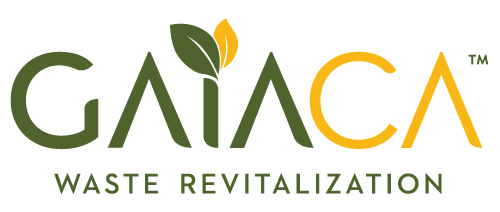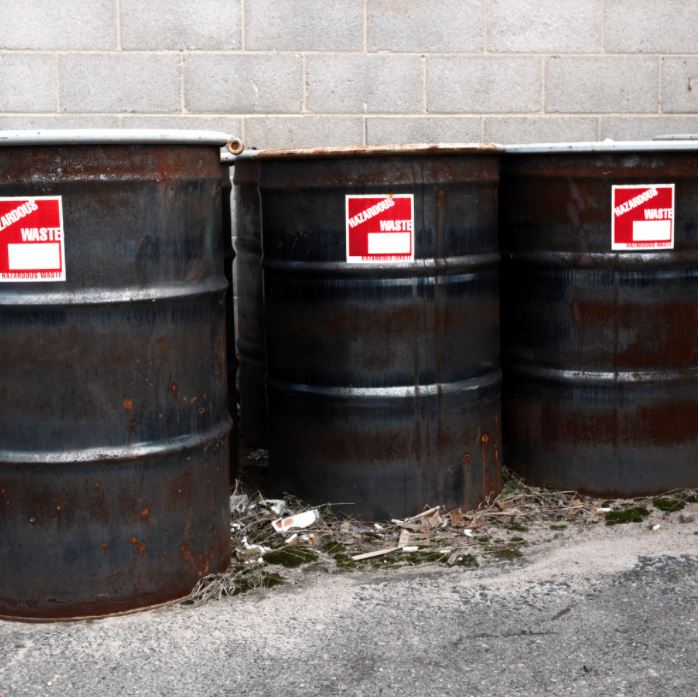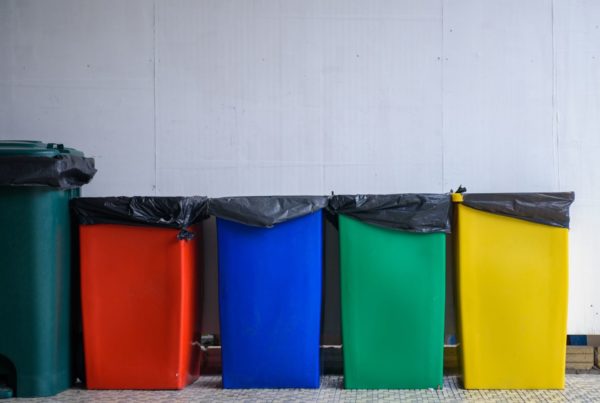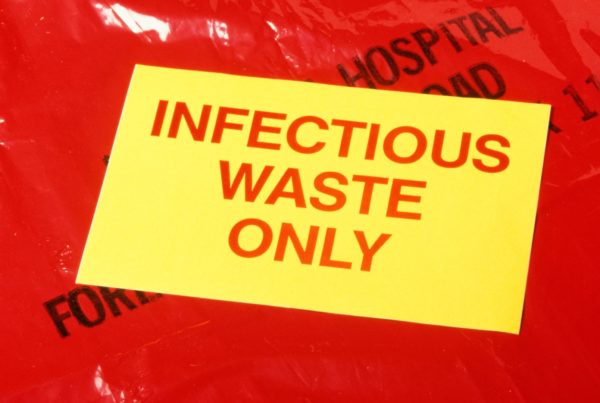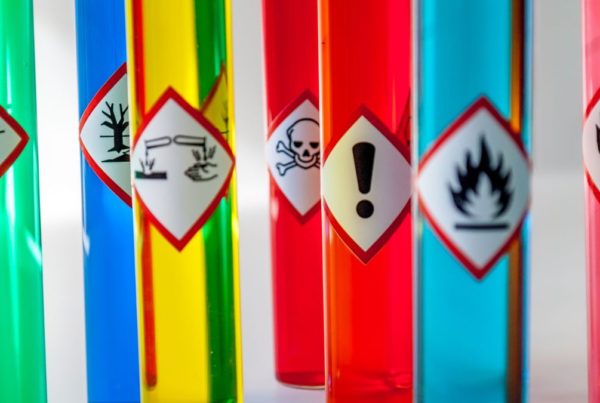In the United States, the Resource Conservation and Recovery Act (RCRA) regulations set out hazardous waste label requirements for substances that may pose a health risk to humans and/or the environment.
These hazardous waste regulations are laid out in the Code of Federal Regulations, title 40, part 262, and all applicable requirements must be followed to the letter by small and large-scale hazardous waste generators.
What Is Hazardous Waste?
According to the Environmental Protection Agency (EPA), hazardous waste is defined as waste that when “improperly managed poses a serious threat to human health and the environment.” This covers four basic categories of hazard, depicted on diamond hazard labels:
- Flammable (red)
- Specific—corrosive, radioactive, etc. (white)
- Reactive (yellow)
- Toxic (blue)
Substances with hazardous properties include the following types of waste:
- Flammable: petroleum, acetone, ethanol, methanol, kerosene
- Corrosive: hydrochloric acid, sulfuric acid, caustic potash, caustic soda
- Reactive: hydrogen, chlorine, organic peroxides
- Toxic: pesticides, heavy metals, asbestos, (most) chemicals
In order to dispose of these waste products effectively, most individuals and businesses that produce hazardous wastes (termed collectively as “generators”) keep a series of bins, drums, buckets, and collection containers in which to store the waste until it can be safely removed.
These containers must all meet hazardous waste label compliance requirements to protect the staff, customers, and anyone else who enters the containment buildings where they’re stored. When storing your waste in containers, note that incompatible wastes (like corrosive and reactive wastes) should never be combined under any circumstances.
Most Hazardous Waste Generators Need an EPA ID Number
Your level of accountability will depend on your hazardous waste generator status. Businesses and individuals that generate a “very small quantity” of hazardous waste material can usually dispose of their waste through household hazardous waste programs. However, any small quantity generator (SQG) or large quantity generator (LQG) that produces more than 100kg of hazardous waste per month will need to obtain an EPA ID number.
The Environmental Protection Agency (EPA) ID is a unique number that identifies generators by site and must be displayed on all bins and containers containing hazardous wastes. This number helps the EPA to keep track of how much waste a generator is producing and apply the permits and prohibitions that are relevant to their category (very small, small, large, etc.).
How to Create a Hazardous Waste Manifest
The hazardous waste manifest regulates the labeling requirements while in transport from the generator facility to the place where the waste will be treated, stored, recycled, or disposed of. The multiple-copy uniform hazardous waste manifest form (EPA Form 8700-22) is required by the EPA and federal Department of Transportation in order to track hazardous waste. It includes the following information:
- The EPA ID of the generator
- The nature and amount of the waste being transported
- Specific handling instructions for the waste
- The names and signatures of all parties involved, including the hazardous waste transporters
A copy of the form is provided to each party in the disposal process, and a complete form is returned to the generator once the disposal facility has received the waste. In some cases, you may be able to complete the process using the digital e-Manifest system.
Labeling Requirements for Hazardous Waste Generation
In order to avoid a hefty fine or even the loss of licensure, it’s essential to know and follow the applicable standards for labeling your hazardous waste. Pre-printed stickers can often be obtained for free with red writing on a yellow background. Regardless of how the label is sourced, it must contain the following information:
- The phrase “HAZARDOUS WASTE” in large, capital letters
- The words “Federal Law Prohibits Improper Disposal. If found, contact the nearest police or public safety authority or the U.S. Environmental Protection Agency.”
- The name, EPA ID, and address of the generator
- The manifest tracking number
- The initial accumulation start date
- The state and EPA waste number (if applicable)
- Whether the container contains liquid or solid waste
- The exact composition of the waste
- A hazard statement calling attention to the primary hazard
- The hazard classification (the EPA recognizes eight hazard classes, including explosives, non-flammable gases, flammable gases, and flammable solids)
Make sure to keep every hazard label consistent throughout your organization. Also note that, in addition to hazardous waste labeling, strict recordkeeping is also required, especially for large quantity generators. You may be responsible for generating waste testing reports, manifests, biennial reports, and more. You’ll also be required to maintain emergency procedures in the event of a hazardous waste spill. This may require specific training protocols for your staff and detailed contingency plans.
Calculating the Accumulation Start Date
Ensuring that the accumulation start date is correct can sometimes become complicated due to the fact that several smaller containers might be emptied into one larger hazardous waste container for consolidation.
In this case, hazardous waste label requirements stipulate that the date on the larger container be adjusted to match the oldest accumulation date of the bins that were added to the container for collection. Smaller bins can also be labeled “recurring use” or “daily” if either of these is the case.
Placement of Labels on the Container
Hazardous waste labels need to be visible and clearly differentiated for clarity. Normally, a chemical hazard label should be placed on the upper side of each container and portable tank—never on the base where it can’t be seen, too close to other markings, or partially covered.
If you have more than one label on the container, they should be separated by a space of at least 6 inches (15cm). This applies in the case that more than one hazardous substance is present. Old labels should be removed or washed off before a container is reused for a new batch of hazardous waste.
Cannabis Waste vs. Hazardous Waste
Cannabis waste is one of a growing number of special waste streams that comes with its own caveats. While cannabis waste must always be labeled, not every cannabis waste stream fits the definition of hazardous or universal waste.
The sector of the canna-industry that is most affected by hazardous waste management standards is the sector that produces extracts—due to the use of flammables like isopropyl alcohol, butane, and ethanol.
The vaping industry is also affected by the standards due to the presence of batteries in vape pens and similar devices. Fortunately, vape pens can often be recycled but must be stored in sealed containers until return.
How to Store Non-Hazardous Cannabis Waste
In contrast to hazardous waste label requirements, non-hazardous cannabis waste such as leaves and trim should simply be stored in a sealed container that’s appropriately labeled with the contents of the container and the accumulation start date.
Once the container has cannabis waste inside, it must be secured (i.e. locked and/or monitored) so that only the licensee, their employees, and the authorized waste management provider have access to the waste. The waste must be rendered “unusable and unrecognizable” before being transported for disposal and/or revitalization.
If you are a cannabis cultivator, manufacturer, or retailer, it’s crucial that you work with a hazardous cannabis waste management company that handles both regular and hazardous waste shipments. From cultivation to sale, hazardous materials (pesticides, solvents, battery-run devices) are often present and need to be disposed of safely and responsibly.
Be Mindful of Your Hazardous Waste Management Procedures
Proper hazardous waste labeling is easy when you understand what’s required. However, failure to follow all EPA guidelines can result in massive fines and other penalties. That’s why it’s a good idea to work with a waste handler that understands the law and is familiar with the waste streams that you manage.
The right waste handlers will help you navigate the regulatory requirements, hazardous waste manifest forms, and time limits for accumulating waste. Put your waste in the best of hands and help protect your staff, the environment, and the good standing of your business.
